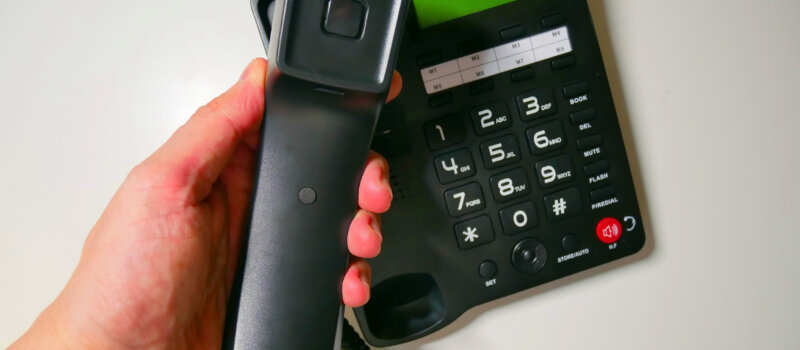If you’ve done any investigation into setting up business phone lines, you’ve likely come across the initialism “PSTN.” What does this have to do with getting a good phone service?
The market for lines on the PSTN is shrinking as consumers and business buyers go elsewhere. A quick overview of the different types of communications systems can help you decide which one is right for your business.
Learn what you need to know about the PSTN and whether a newer alternative is better.

Key Takeaways:
- PSTN refers to the traditional landline telephone system that runs over copper wiring.
- Many countries are phasing out the PSTN because the technology is obsolete and expensive to maintain.
- Cloud-based communications using VoIP are supplanting the PSTN due to having more features, being more flexible, and offering greater cost savings.
What Is the PSTN?
PSTN stands for public switched telephone network. It is the basic phone utility that has been in use since the late 1800s. Parties connect with a seven-digit phone number for local calls and 11 digits for long-distance and international calls.
Industry professionals may use “PSTN” to distinguish this system from other telecommunications offerings. However, in everyday conversation, people more often refer to this as a landline. Other terminology is fixed voice, analog, and more recently, POTS, which stands for “plain old telephone service.”
How Does the PSTN Work, and What Are Its Benefits?
The first phones required copper wires connecting directly from one device to another to transmit audio. Phone companies sprung up when they figured out they could run all lines in one area into a single office and connect any two parties that way.
A person would ring that office and ask the operator to connect them to someone else. The operator would have to physically plug in the caller’s wire into the pathway to their intended recipient. Phone calls on the PSTN still work the same way today except that switching between calls now happens automatically, without the need for a human operator.
As telecommunications companies connected different branches to each other, a web of voice connectivity extended across the whole world. Advances eventually allowed features like conference calling for multiple parties and radio signals that permitted mobile connections.
What Are the Drawbacks of the PSTN?
While the PSTN is still a reasonably reliable system, it has disadvantages in comparison with modern communications solutions.
Cost
Because the PSTN relies on physical hardware that degrades and requires continual maintenance, this adds to the cost of using the service. Long-distance calls are particularly expensive. You must also purchase or rent specific hardware to connect telephone lines for each user on your service.
When you need to add a member, that requires installing a new line. Consequently, you have to hire a technician to handle this complex work. For technical difficulties, you have to pay an IT professional to take care of it, which often requires long wait times that cut into your revenue.
Inflexible
Landline phones tie your team to their desks. While you may be able to set up a forwarding service to connect to mobile phones, this usually involves multiple providers or services, which adds to the complexity, confusion, and costs.
The PSTN can also only handle voice calls. If you want to add video calls, text messages, and other channels, you need another service. Services like transferring, voicemail, and recording are also clunky and expensive. Furthermore, having these services work together for coordination and data collection is difficult and time-consuming.
Less Security
The PSTN lacks the protection of digital options because it cannot integrate with security systems in the same way. Wiretapping and call interception are hard to defend on landlines.
Shutoffs
If there is no other reason to leave the PSTN, it should be because entire countries are abandoning it. The Netherlands, Estonia, and Australia have already stopped using it.
The United Kingdom will shut the PSTN down in 2025, and other countries are making plans to eliminate it, including the United States. Changing services now prevents later complications.
Are There Any Alternatives to the PSTN?
The rise of high-speed broadband internet has allowed a less expensive, more secure, and more advanced alternative to the PSTN. This newer telecommunications option is Voice over Internet Protocol (VoIP).
As you might guess from the name, the VoIP system sends your audio over the internet in digital data packets instead of analog signals over copper wiring. Other names for this system are broadband telephony, internet telephony, virtual phone systems, online phones, cloud-based phones, or IP telephony.
How Does VoIP Outperform the PSTN?
VoIP resolves most of the drawbacks with the PSTN and provides numerous benefits, such as:
- Lower costs: VoIP requires less equipment and has lower operating costs than using the PSTN.
- Greater security: Your service operates from secure centers that protect your data and preserve business continuity during emergencies.
- Advanced features for productivity: VoIP lets you connect business software to your phone system to collect, organize, and share data more efficiently.
- Future-proof functionality: Digital connectivity in a subscription model allows you to get the latest features as they arrive, such as artificial intelligence.
- Better support: Count on 24/7 technical support to troubleshoot any issues.
With so many benefits, it makes sense to switch over to VoIP as soon as possible. As a digital solution, it’s easier than ever to move over to VoIP’s cloud-based calling. Simple setups can even be operational on the same day!

Get Off of the PSTN and Onto VoIP With Intermedia
Clearly, the PSTN is fading away as cloud-based solutions are ascending. Discover how Intermedia can help you switch to VoIP and still keep your number and existing equipment. Set up a callback with us today to learn more.
March 28, 2024
Explore other posts on these topics:



